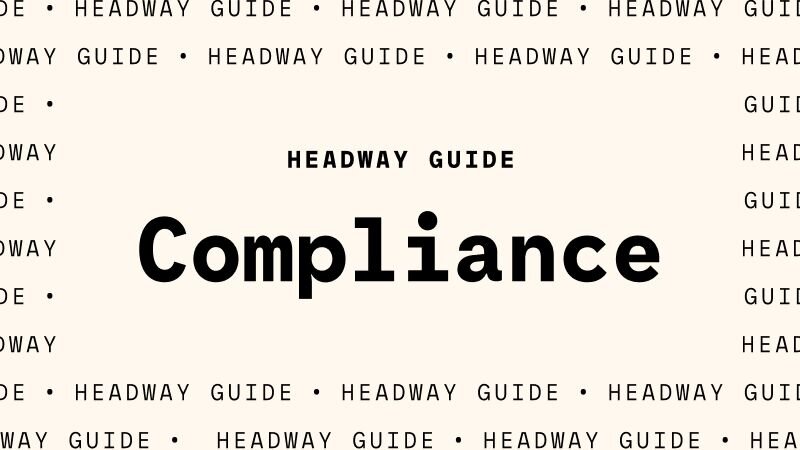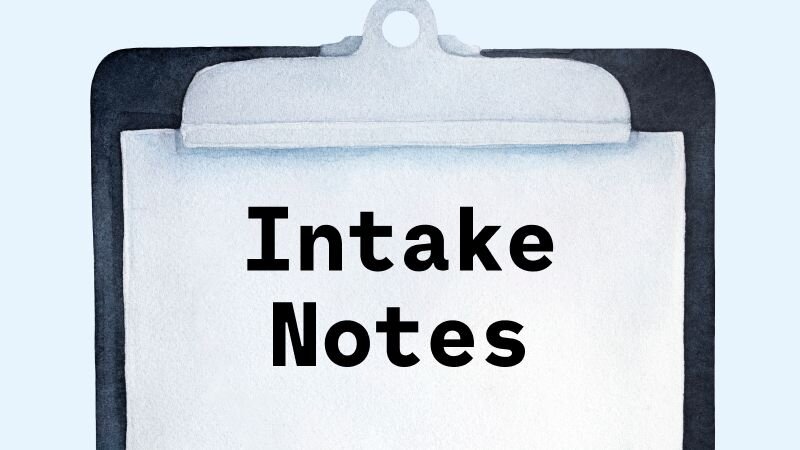
Compliance— a Headway Guide
Navigating compliance can be time-consuming and stressful. We’re committed to changing that.

Progress notes are the core piece of documentation a mental health care provider should write after each session with a client, but it’s more than just a record of what happened in the session.
Progress notes are aptly named: It’s a documentation of each session with your client where you share the progress you’re making on your treatment goals. Specifically, the treatment goals you aligned on in your treatment plan.
Simple, right? Not always, when you’re navigating insurer requirements and billing standards.
“I often hear from providers I work with that the concept of progress notes is ‘easy,’ but writing them in a compliant way is the hard part,” says Innocent Turner, Clinical Strategy and Quality Manager at Headway.
If the “rules” for writing compliant progress notes are confusing and vague, that’s because they’re left open for you to step in as the expert.
Other than following the advice in this article (or using a great template), Innocent recommends a quick gut check.
Read your progress notes back to yourself and reflect: Does this accurately portray what happened? Or is there an element of treatment that didn’t make it onto the page? If you feel like you’ve forgotten something, you probably did, but you can always figure out a way to include it.
This guide will help you understand the purpose of progress notes, what to include in your session documentation, and helpful templates and examples to get you started.
When you’re a Headway provider, you get complimentary access to built-in documentation templates designed to make your note-taking fast, easy, and compliant.
Learn more about Headway’s EHR features and enhanced rates today; and start seeing insurance clients in less than 30 days.
Progress notes are the core piece of documentation a mental health care provider should write after each session with a client, but it’s more than just a record of what happened in the session. Progress notes keep a record of the client's progress and the care you provide.
“When someone reads a note, they need to understand how your patient presented, what's going on with them right now, how you helped them, and how they received that help,” says Innocent Turner, LCSW and Headway’s Clinical Strategy Lead. “And if those questions are answered for the most part, you’re good.”
It’s also important that clear continuity of care is documented: While each note should lead into the next, each note should also stand alone, demonstrating a clear and comprehensive story of the client's progress through treatment.
You don’t need to include everything your client said in your progress notes, only what pertains to their treatment. If they spend the first 5 minutes complaining about their in-laws, don’t worry about capturing that in your documentation.
A complete patient chart contains three core pieces of clinical documentation: an intake assessment, treatment plan, and progress notes.
Think of these as the “golden thread”: Your intake note should inform your treatment plan, and your treatment plan goals and objectives should be reflected in each progress note.
Here are the key details of the different types of documentation:
Clinical documentation is a staple of any mental healthcare practice — it’s used to clarify the purpose of your sessions, justify the billing code used, and demonstrate a good picture of the patient’s current mental state.
These standards are outlined by the American Medical Association (AMA), Centers for Medicare and Medicaid Services (CMS), National Committee for Quality Assurance (NCQA), commercial insurers, and other regulatory agencies.
Your license or a particular insurer may have even stricter requirements than those set forth here.
Your progress notes need to contain the following details in order to effectively capture the progress you’re making with the client towards their goals.
These easy-to-note facts are required for all documentation, including your progress notes:
Person-centered details are session-specific information that paints a helpful picture of the client's mental state and feelings, in their own words. Infusing specificity into your notes — such as the use of quotations from your client — helps insurers verify that the session was unique and veritable, and that you didn’t simply copy and paste from a previous session.
Your notes should reflect a clinical assessment of your client’s current mental state in order to portray the full picture of their symptoms, diagnosis, and treatment. As a guide, each progress note should include at least three components of the mental status exam, such as descriptions of the patient’s appearance, behavior, alertness, reasoning, or mood.
Make sure you identify progress towards the goal(s) outlined in your treatment plan, including whether the client made progress, regressed, or stayed about the same. Insurers review this item frequently; it's one of the most commonly missed. If you need to update the treatment plan, say that too. This will support the CPT code you're using and offer clarity if treatment goals change frequently (as they sometimes do).
Because this is a sensitive area, it's especially important to clearly and completely document any risks in your progress note — it must also be unique to each session. Documentation of risk can be simple such as "client denies all areas of risk." That said, if you identify a risk, you are required to identify the client's risk level and create and document a safety plan. In these cases, you don't need to document the safety plan in the progress note itself, but you do need to include a note that the safety plan was created and the client agreed to it. For example, you might write "safety plan was discussed and reviewed with client."
Progress notes should outline the evidence-based practice used in the session, and comment on any changes in modality. You might also include any skills that may be helpful for clients to practice to help manage or reduce their symptoms, and why it would be helpful in reducing their symptoms.
Because progress notes are required for every session through insurance, it’s helpful to leverage a template to help you complete your notes quickly and comprehensively.
Three of the most common progress note templates include:
Here’s an example of a progress note that meets most insurance carriers’ expectations for this type of clinical documentation. It follows the SOAP note template:
Notice how it contains all 6 of the primary requirements for a compliant note.
Client Full Name: Katie Client
Client Date of Birth: 9/9/1999
Date of Service: 3/08/2023
Exact start time and end time: 10:23 am – 11:20 am: 57 mins
Session Location: Telehealth, patient provided consent to telehealth, service performed on HIPAA compliant software
Subjective notes:
Katie presents today’s session feeling “depressed.” She states that her mood has been “getting worse.” She reports that she has been struggling to get out of the house to enjoy social events that she is actually interested in, then becomes more frustrated with herself. She describes an increase in sleep issues, both difficulty falling asleep and staying asleep. Katie says that she “just wants to be better.” Katie continues to endorse low energy, loss of interest in activities, difficulty sleeping, and feelings of guilt, although she is not able to express the source of her guilt.
Objective notes:
Therapist helped Katie process her feelings, provided in depth psychoeducation on guilt and how it relates to depression. Katie’s mood throughout the session was low, flat affect, her speech is low volume and soft. Therapist used the CBT triangle in session to assess Katie’s ability to identify patterns in behavior and thoughts. Katie required extensive guidance to understand the concept of the thought triangle. Therapist explored her feelings of guilt at length, and used socratic questioning to fully engage with past experiences that may be triggering guilt/shame. Therapist helped Katie process how her feelings influence her behavior (CBT triangle) and discussed in depth behavioral patterns that potentially are increasing her depressive symptoms.
Assessment:
Katie continues to struggle with depressive symptoms, primarily guilt, making it difficult to engage with her surroundings as she desires. She lacks insight into her diagnosis, often saying things like “if I don’t want to be depressed then why am I depressed.” She required extensive socratic questioning to help her gain a little more insight into her diagnosis and feelings of guilt/shame. She denies SI/HI/AVH. She is struggling to make progress toward her goal of identifying triggers or past experiences that contribute to her feelings of guilt and worthlessness, as she requires redirection to provide relevant examples and/or to clarify her comments.
Plan:
Therapist will continue to use CBT informed treatment to help Katie learn coping skills to manage depression symptoms and specifically guilt. For the next week, therapist asks Katie to consider her core beliefs and the source of her core beliefs. She was provided a worksheet to help clarify what core beliefs are and some potential sources. Therapist recommends meeting in one week, Katie will schedule the next session.
Client Signature and Date:
Katie Client, 3/8/23
Clinician Signature and Date:
Olivia Wells, LMFT, 3/8/2023
This document is intended for educational purposes only. Examples are for purposes of illustration only. It is designed to facilitate compliance with payer requirements and applicable law, but please note that the applicable laws and requirements vary from payer to payer and state to state. Please check with your legal counsel or state licensing board for specific requirements.
Progress notes are a requirement for billing sessions with insurance, but they also simply provide a written record of the care you delivered.
Even therapists who operate their practices through self pay should document progress notes. There may be times when thorough mental health care documentation becomes important, such as if your client transitions to a new provider or ends up in a health crisis or legal proceeding.
“If your patient is in some type of crisis — not even a mental health crisis but something like a car accident — they may end up in a hospital telling their care team, ‘yeah I see a therapist’,” says Turner. “Their care team might need to know what’s been going on in your care, so they can provide consistent care — like not giving medication that might cause issues.”
It’s important to choose the medically appropriate billing code for the correct service delivered, and ensure your documentation supports and substantiates the service.
Notes associated with 45-minute sessions should include a connection to the client’s diagnosis, symptoms, and plan, as well as details about how the session impacted their symptoms.
A 60-minute session note should include all the same details, as well as notes relating to medical necessity of why extra time was needed for more intensive treatment. This doesn’t have to be extensive – it just needs to be directly acknowledged. (You can find examples of medical necessity statements to help you craft your notes.)
It’s important to use the code that most accurately reflects the time you spent with the patient to treat their condition, and ensure that documentation for the session supports the chosen code.
Documentation of relevant aspects of client care, including documentation of medical necessity, should ideally be completed within 24 hours of visit, and no later than 72 hours.

Navigating compliance can be time-consuming and stressful. We’re committed to changing that.

The intake assessment is your chance to get a deep understanding of your patient — and maybe connect some elements from their journey that they wouldn’t connect themselves.

Whenever you want to change the goal of your therapy care, or the path you want to take with the client to reach that goal, you’ll want to document a treatment plan.